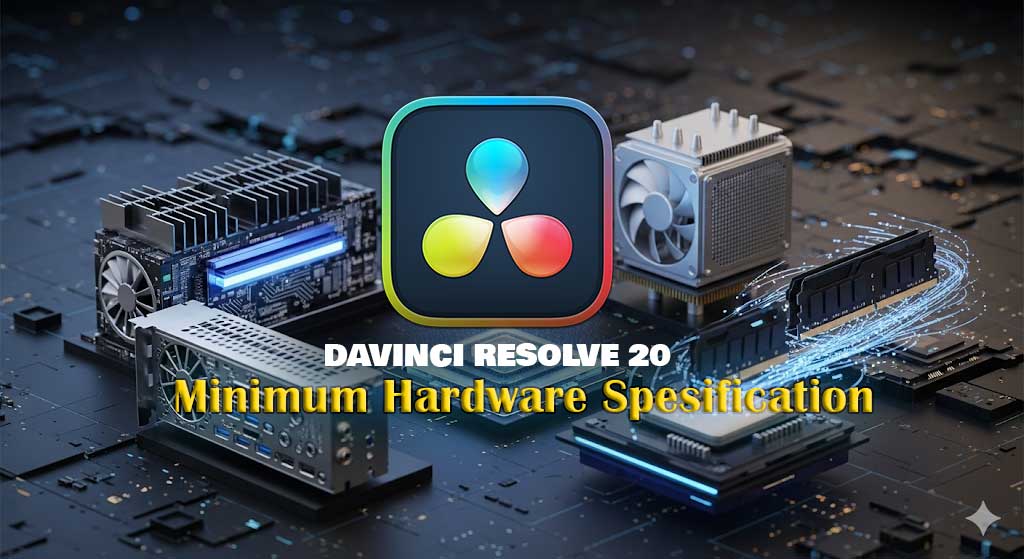DaVinci Resolve 20: Minimum Hardware Specifications and Key Components for Maximum Performance
Say hello to DaVinci Resolve 20, the New Era of AI Editing
DaVinci Resolve has long been the industry standard for color grading and post-production. With the release of version 20, Blackmagic Design hits the market again with the integration of artificial intelligence (AI) revolutionary. Features such as AI IntelliScript, AI Animated Subtitles, and AI Multicam SmartSwitch promise a much faster workflow.
However, these advanced capabilities certainly demand more from your hardware. This article will explore the minimum specifications you need to run DaVinci Resolve 20 on various platforms, ensuring your editing experience goes off without a hitch.
Minimum Hardware Specifications for DaVinci Resolve 20
Although version 20 brings many innovations, the basic hardware requirements are still in line with previous versions, but with greater emphasis on certain components.
1. For Windows Users
- Operating System: Windows 10 or Windows 11 64-bit.
- CPU: Intel Core i7 or AMD Ryzen 7 or equivalent.
- RAM: 16 GB RAM is the minimum, but 32 GB or more is highly recommended, especially when using AI features or working with high resolutions (4K/8K).
- GPU: Graphics card with at least 4 GB VRAM. For optimal performance, a modern GPU from NVIDIA (RTX 3060 and above) or AMD (Radeon RX 6000 series and above) is recommended.
- Storage: SSD (Solid State Drive) for operating system and project files is mandatory. Minimum 10 GB of free space.
Key Points: The AI features in DaVinci Resolve 20 rely heavily on the GPU. Investing in a powerful graphics card will go a long way in determining the speed of the rendering and processing You.
2. For macOS Users
- Operating System: macOS 12 Monterey or later.
- CPU: Intel Core i7 or Apple Silicon (M1, M2, M3, or later series).
- RAM: Minimal 8 GB RAM (16 GB or more is recommended).
- GPU: The integrated GPU on Apple Silicon is highly optimized. For Intel-based Macs, a GPU with at least 4 GB of VRAM is required.
- Storage: SSDs are highly recommended.
Key Points: DaVinci Resolve 20 continues to be optimized for Apple Silicon, making it a highly efficient choice in terms of performance and power consumption.
3. For Linux Users
- Operating System: CentOS 7.3, Rocky Linux 8.6, or Ubuntu 18.04 LTS (or later).
- CPU: Intel Core i7 or AMD Ryzen 7.
- RAM: 32 GB RAM is the recommended minimum for a stable experience.
- GPU: NVIDIA or AMD GPU with at least 4 GB VRAM. Make sure the GPU driver (CUDA or OpenCL) is installed with the latest version.
- Storage: SSDs are a must for maximum performance.
Key Points: Linux users who work in professional environments are highly recommended to use NVIDIA GPUs due to their more complete driver support and features.
Key Components: Which is the Most Important?
While all components work together, there are three hardware elements that are most crucial for a smooth DaVinci Resolve 20 experience:
- GPU VRAM: This is the main determining factor. The bigger the VRAM, the faster rendering, color gradingThe use of AI, and the heavy use of AI effects. Minimum 8 GB VRAM is ideal for 4K work.
- RAM: If you're just doing light editing, 16 GB might be enough. But for big projects, Fusion, or new AI features, 32 GB or more will prevent lag and crash.
- SSD: Make sure you have a fast SSD for the operating system and cache storage. High read/write speeds will eliminate the problem of playback and accelerate rendering which the new features desperately need.
Cover: Is Your PC Ready?
DaVinci Resolve 20 is a huge leap forward in the world of video editing. However, without the proper hardware, you won't be able to experience its full potential. Before you start editing, make sure you meet the above specifications so that you can focus on creativity instead of technical issues.


